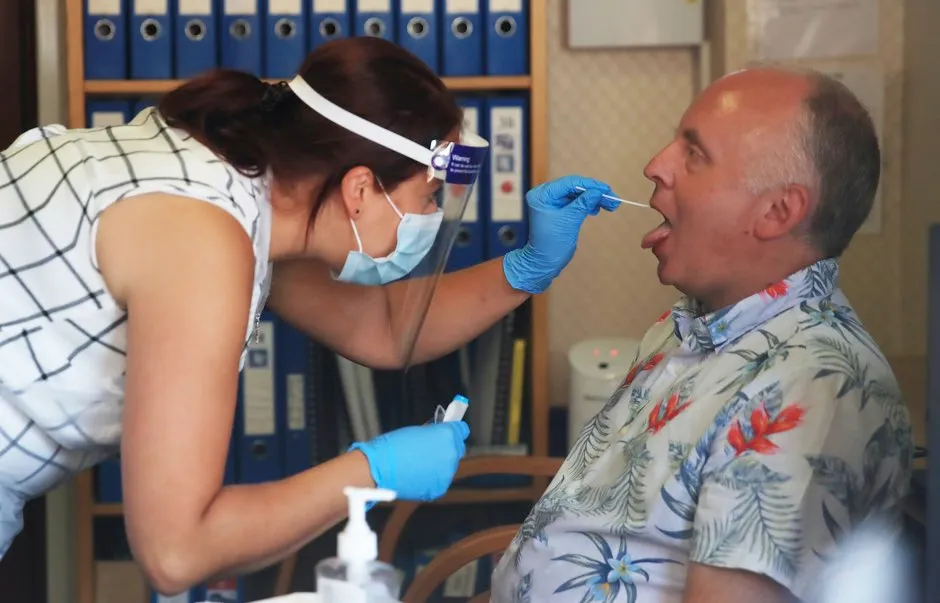The UK is not at the beginning of a second coronavirus wave, and is still trying to end the first, new data suggests.
There were 1,434 daily new cases in the UK on average over the two weeks up to 8 August, excluding care homes, according to the latest COVID Symptom Study app figures.
The latest figures are based on the data from 10,988 swab tests taken between 26 July and 8 August.
Read more coronavirus news:
- Children play 'limited role' in coronavirus pandemic
- ‘Atypical symptoms’ common in care home patients
- American vaccine produces 'robust immune response' in human trials
The latest prevalence figures estimate that 24,131 people in the UK currently have symptomatic COVID-19.
According to the data, the amount of symptomatic coronavirus nationally has remained stable.The numbers are still higher in the North of England but have slightly decreased since last week.
The figure does not include long-term COVID-19 sufferers.

The COVID Symptom Study app’s prevalence estimate is lower, but still within the confidence bounds of the most recent ONS Infection survey last week, with an estimated 28,300 people in England during the one-week period from 27 July to 2 August.
Tim Spector, professor of genetic epidemiology at King’s College London and leading the COVID Symptom Study research, said: “It’s encouraging to see that the numbers are coming down slightly across the UK and that the isolated outbreaks in the North of England appear to be well contained so far.
“This is further confirmation that we aren’t at the beginning of a second wave and rather, still trying to end the first. The figures also suggest that the outbreaks we are seeing in other countries such as Belgium, France and Spain aren’t having an effect here in the UK yet.
“On top of this, the hot weather which caused concern by making many flock to crowded beaches and parks doesn’t seem to be having the predicted negative impact.
“Overall, we are pleasantly surprised by the figures this week, which are back down to the early July levels and hope that the good news continues.”
Read more about how tech is helping in the fight against COVID-19:
- Project Discovery: Could computer games help find a cure for COVID-19?
- How will the new NHS contact-tracing coronavirus app work?
The COVID Symptom Study app’s Watch List highlights key areas of concern so they can be focused on.
This week a number of new locations have made the list, including the first area in Scotland, Dumfries and Galloway, Thurrock in Essex, and more regions in the North of England, St Helens, Middlesbrough, Blackpool and Lancashire.
Blackburn with Darwen has fallen from the top spot to sixth in the table, while Halton in Merseyside has moved to the top slot, making it the one to watch.

When an area of concern is highlighted, it means enhanced testing can take place to help confirm if the situation needs further action such as a localised lockdown.
Developed by healthcare science company ZOE, the COVID Symptom Study app has been downloaded by more than 3.9 million people in the UK.
Data collected is shared with and analysed by King’s College London.
What is the R number, and why is it relevant to coronavirus?
The reproduction number – often called the R value or R number – is a measure of a disease’s ability to spread. It tells us how many people a single infected person will pass on the disease to.
The R number for COVID-19 that’s being quoted in the media and government briefings is what’s known as the ‘effective’ reproduction number. This value can go up and down.
We can reduce R by making it harder for the disease to spread, by implementing measures such as social distancing, closing restaurants and non-essential shops, and encouraging people to stay at home.
Every disease also has what’s called a ‘basic’ reproduction number, R0, which is the fixed value of R if no measures are put in place. For example, measles is highly contagious, with a R0 as high as 18, while COVID-19 has a R0 of around three.
So if COVID-19 was allowed to spread through the population, an infected person would, on average, give the disease to three other people.
But if all these people are practising physical distancing, then the virus can’t spread so easily and the effective R value goes down.
The crucial thing is to keep R below 1. If we can do this, then the number of new cases dwindles and the outbreak will eventually come to a halt.
Conversely, if R rises above 1, then we run the risk of rapidly escalating case numbers that would require stronger measures to keep the virus under control.
Because of this, R is used by governments to assess how we are doing in our efforts to stop the spread of COVID-19, and to adjust our actions, if needed.
Read more:
